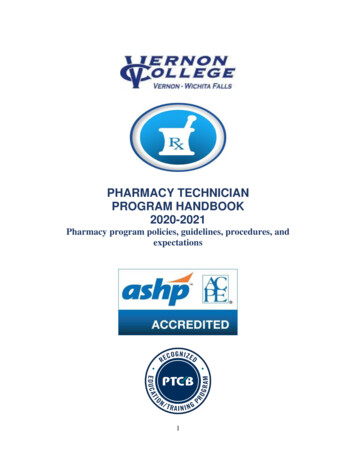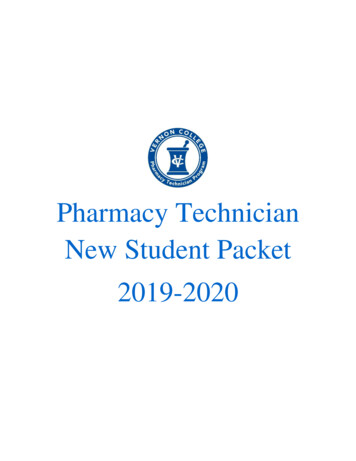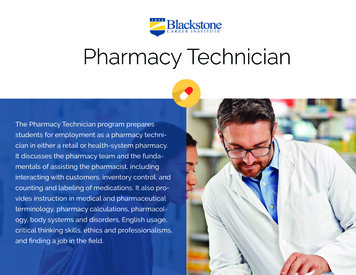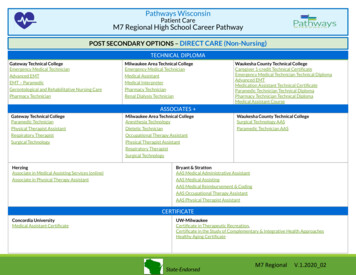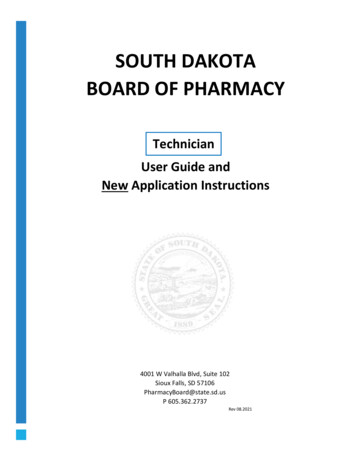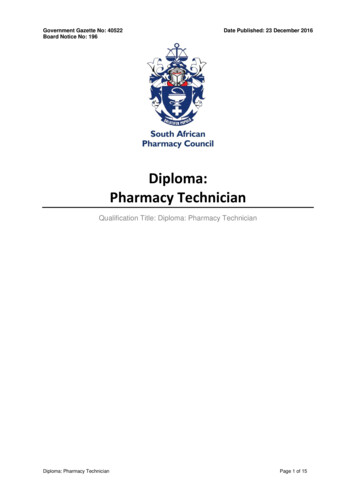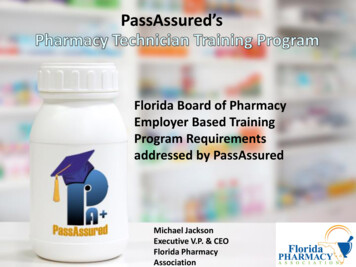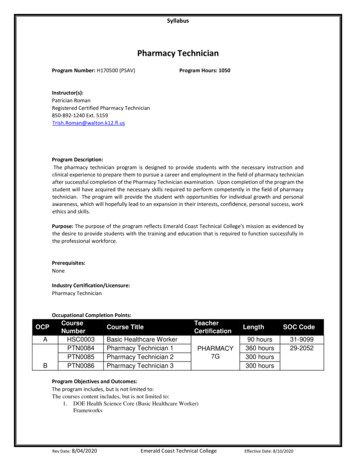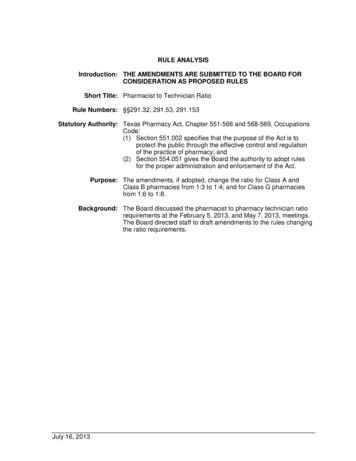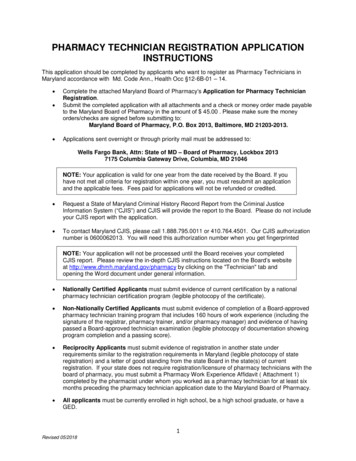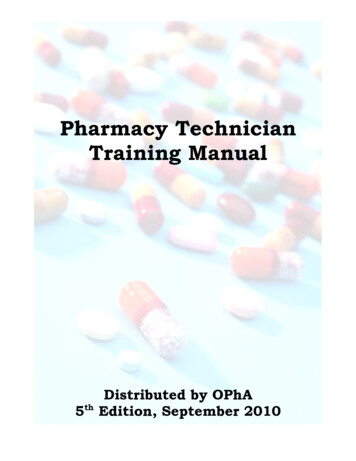
Transcription
Pharmacy TechnicianTraining Manual5thDistributed by OPhAEdition, September 2010
2
CONTENTSPage1. Introduction42. Pharmacy Technician Certification Board53. Pharmacy Technician Training Guidelines64. Phase 1 Training75. Phase 2 Training146. Appendixes Appendix 1: Confidentiality of Patient Information21 Appendix 2: HIPAA22 Appendix 3: Pharmacy Technician and SupportivePersonnel Rules23 Appendix 4: OBNDD Pseudoephedrine Control 3337Appendix 5: Terminology Appendix 6: Abbreviations40 Appendix 7:Measurements41 Appendix 8: Sample Work Schedule42 Appendix 9: Auxiliary Labels43 Appendix 10: Definition of the Practice of Pharmacy453
IntroductionIn May of 1993 the Oklahoma State Board ofPharmacy asked the Oklahoma PharmaceuticalAssociation (OPhA) to develop a Pharmacy TechnicianTraining Manual.The purpose of the fifth edition of this manual isto provide pharmacies and pharmacists in the state atraining manual of pharmacy material that has beenapproved by the Oklahoma State Board of Pharmacy.Due to increased quantity of prescriptions inrecent years, there has been an increased demand forpharmacy staff. The increased use of pharmacytechnicians should increase efficiency and quality ofpharmaceutical care. However, the pharmacist mustlive up to the full potential of his or her professionalroles and responsibilities. “Tech” will be the term usedfor pharmacy technician in the manual.4
Pharmacy TechnicianCertification BoardAlthough not required for licensure, some techniciansmay choose to get certified. Some employers either requirecertification or may offer incentives for certification. ThePharmacy Technician Certification Board (PTCB) offers anational examination that once passed confers the CertifiedPharmacy Technician (CPhT) credentials. This certificationincreases credibility and adds a level of greater emphasis,responsibility and benefits. The PTCB offers the exam threetimes a year at nearly 120 sites across the nation. For moreinformation, see http://www.ptcb.org.Numerous websites offer additional training materials forthe examination. You can learn about the content of the examand how to prepare by visiting www.ptcb.org and following theexam link at the top of the page.5
OKLAHOMA STATEBOARD OF PHARMACY:PHARMACY TECHNICIANTRAINING GUIDELINESAll pharmacy technicians must have satisfactorilycompleted an initial Pharmacy Technician Training Program,Phase 1, prior to receiving a Pharmacy Technician Permit.After receiving the permit, they may begin on-the-job training(OJT), Phase 2, in the prescription department.This program must be taught in each pharmacyemploying pharmacy technicians. The development orimplementation of a program is the responsibility of thepharmacist manager, who may be requested to submit theinstructional text of the training program to the State Board ofPharmacy for approval.The pharmacist manager, or another pharmacist in thepharmacy whom he or she may designate, shall conduct thetraining and attest to its successful completion. Proof of thistraining and subsequent training must be maintained in thepharmacy and available for inspection.The Oklahoma State Board of Pharmacy has set thesePharmacy Technician Training Guidelines as minimumstandards for training of pharmacy technicians.The training program may be adjusted to meet thespecific needs of an individual, but the adjusted program mustconform to the minimum standards in these guidelines.6
Phase 1(Initial Training)I.II.Orientationa. Tour of Pharmacyi. Location of Medicationsii. Prescription Filesiii. Information Sourcesiv. Insurance Informationv. Other areas deemed appropriateb. Organization Chart (chain of command)i. Describe your store’s organizational chart. The pharmacist isalways responsible for the tasks the technician completes.c. Policy and Procedures Manual (if one exists)i. The development of a policy and procedure manual is highlyrecommended.d. Confidentiality of Patient Informationi. See Appendix 1e. Health Insurance Portability and Accountability Act of 1996. (HIPAA)i. See Appendix 2f. Patient Information Literaturei. There are several prescription medications that require patientpackage inserts when a prescription is dispensed. Examples arePremarin, birth control pills, etc. Other useful information to helpinstruct a patient is also available. The tech should be able to helpthe pharmacist in maintaining these sources of information.g. Reference Sourcesi. The tech should know:1. Where the reference books are located in the pharmacy2. Legal requirements pertaining to keeping an updatedpharmacy library. (See Rules and Regulations section ofcurrent Law Book)h. Name Tagsi. The public should be able to distinguish the pharmacist from anysupport personnel in the pharmacy. All support personnel must bedistinctly identifiable from a practicing pharmacist. Name and jobtitle should identify “Tech” from other support personnel.i. Dress Codei. Each pharmacy should determine the dress code, however ingeneral a clean and professional appearance is desired.Job Descriptiona. Role of Pharmacisti. The pharmacist is responsible for all judgmental tasks involved indispensing a prescription and for maintaining good pharmaceuticalcare.7
ii. The pharmacist is responsible for all counseling and shall notdelegate this task to anyone. An intern is allowed to counsel ifdeemed appropriate by the pharmacist.iii. The pharmacist may delegate non-judgmental tasks to be done, butthe responsibility, both legally and professionally, stays with thepharmacist.iv. The pharmacist’s duties are a provision of those acts or servicesthat are necessary to provide pharmaceutical care.b. Role of Support Personneli. The supportive personnel may perform tasks other than those of apharmacist or technician.ii. See appendix 3 for an excerpted portion of the OklahomaPharmacy Law Book pertaining to duties of technicians andsupportive personnel.c. Role of Pharmacy Techniciansi. May perform any duties supportive personnel are allowed toperformii. Count and/or pour medicationsiii. Prepackage and properly label medications (i.e. unit dose)iv. Affix auxiliary labels to the container as directed by pharmacist.v. Affix the prescription label to proper containervi. Reconstitution of medication (i.e. liquid antibiotics)vii. Bulk compounding, including such items as non-sterile topicalcompounds, sterile irrigation solutions and products prepared inrelatively large volume for internal or external use.Documentation of a system of in-process and final checks andcontrols must be developed or approved by the certifyingpharmacist and carefully and systematically enforced.viii. May perform functions involving reconstitution of single doseunits of parenteral products that are to be administered to a givenpatient as a unit, and perform functions involving the addition ofone manufacturer’s prepared unit (whole or part) to anothermanufacturer’s prepared unit, if the unit is to be administered asone dose to a patient. The pharmacist must establish proceduresfor parenteral products and certify the ingredients, and label thefinished product.ix. May assist the pharmacist in the annual Controlled DangerousSubstance inventory. The pharmacist remains responsible forcompleteness and accuracy.d. Personal Attributesi. Self Confidence: Knowing when and whom to ask for help is partof self-confidence.ii. Knowledge: Using the training given, the tech may help thepharmacist in knowing a patient and remembering what hasoccurred in the past regarding the patient.8
III.IV.iii. Sincerity: The combination of honesty, common sense anddiplomacy may be characterized as sincerity. Show concern forthe patient.iv. Concern for others: A concern for others, coupled with empathy,open-mindedness and understanding of their opinions or situationis important. Try to look at their point of view. Are there otherhelpful options?v. Tact: Tact is an important aspect of verbal communication in anypharmacy.e. Pharmacy Technicians interrelationships with:i. Pharmacists: All tasks performed by the tech are the ultimateresponsibility of the pharmacist. The tech works under direct andimmediate supervision by the pharmacist, as stated in the StateBoard Rules. The tech should present any problems ordiscrepancies to the pharmacist.ii. Patients: The tech should be courteous and tactful when obtaininginformation. Refer all medication questions to the pharmacist.iii. Physicians: The tech should be courteous and identify themselves.Refer all medication questions to the pharmacist.iv. Nurses and/or medical office staff: Refer all medication questionsto the pharmacist.Communication Techniquesa. Telephone Etiquette and protocoli. It is necessary and important that you always identify yourself as atechnician when communication via telephone. Whether answeringa call at the pharmacy or phoning a doctor’s office or insurancecompany.1. Example 1) “Thank you for calling (your store name here),my name is (your name here), technician, how may I helpyou.”2. Example 2) “Hello my name is (your name here), I’m atechnician with (your store name here.) .”ii. Basic communication skills: Always communicate with a helpfulattitude.iii. Be an active listener.iv. Communication is a two way street.v. Articulation: the use of precise words to describe a situation.vi. Pleasant voice: speak slowly, distinctly, and pleasantly. The callercannot see facial expressions so the voice is all important.vii. Friendliness is one of the easiest and most effective tools of goodcommunication.viii. Listen attentively and patiently. Do not assume you know what isgoing to be said; wait for the person to finish before responding.Pharmacy Laws and Rulesa. Pharmacy Law – refer to Oklahoma Pharmacy Law Bookb. Pharmacy Rules9
i. Transfer of prescriptions: only the pharmacist or intern is allowedto transfer a prescription.ii. Interns may perform all functions of a pharmacist, except the finalcheck of a prescription.iii. Telephone prescriptions: only a pharmacist or intern is allowed totake new prescriptions.iv. Pharmacy access: only a pharmacist shall be permitted to unlockthe pharmacy area or any additional storage areas for dangerousdrugs, except in an extreme emergency.v. Refill authorization records: when an agent of a licensedpractitioner calls in a refill, the name of the person shall bedocumented.vi. Drug Expiration dating: all outdated prescription drugs shall beremoved from the active inventory area upon expiration and cannotbe used to fill prescriptions. The removal from the pharmacy ofthese expired drugs must occur within six months; either bydestruction or by being returned to the supplier.c. Drug Enforcement Administration (DEA)i. Identification of DEA drug labelsii. Ordering and Receiving of controlled dangerous drugsiii. Rationale of DEA drugsiv. Inventory and/or accountability: the Tech is allowed to help thepharmacist in the actual inventory which must be performedbetween May 1 and July 1.v. Storage of controlled substances.vi. Filing Systems: Different types of filing are allowed. The techshould know which type of filing is being utilized in the pharmacy.vii. Exempt Narcotic Sales: The pharmacist is required to handle thesale of all exempt narcotics.viii. Formula for calculating and confirming DEA number: Add thefirst, third, and fifth digits of the DEA number. Then add thesecond, fourth, and sixth digits; and multiply this sum by 2. Addthe two numbers. The last digit of this sum will be the same as thelast digit of the DEA number.1. EXAMPLE: DEA # 1234563a. 1 3 5 9, 2x(2 4 6) 24 TOTAL 33ix. OSTAR: Requirements and working of the CII narcotic trackingsystem.x. Regulation of mailing prescriptions: Through US Postal Service,UPS, FedEx, etc.xi. Requirements relating to prescriptions transmitted by physicianassistants.xii. Prescribing limitations of optometrist, podiatrist, dentist,veterinarian, etc.10
xiii. Record keeping for all control dangerous drug prescriptions:Length of time prescriptions are valid depends on Schedule ofDangerous Drugs.d. Transfer prescriptions:1. Schedule II – may not be transferred2. Schedule III-V – may be transferred ONE time only.However, pharmacies electronically sharing a real-time,online database may transfer up to the maximum refillspermitted by law and the prescriber’s authorization.e. Classification of Drugs:i. Schedule I1. High potential for abuse2. No accepted medical use in treatment under medicalsupervision3. Heroin, marijuana, LSDii. Schedule II1. High potential for abuse2. Currently accepted medical use in treatment in US, orcurrently accepted medical use with restrictions.3. The abuse of the substance may lead to severe psychic orphysical dependence/addiction4. Meperidine, morphine, amphetamines, Ritalin, Percocet,Tylox.5. Require a written prescription that is not physically altered,filled within 30 days, and cannot be refilled.6. The patient must also present a valid ID when filling aprescription for a scheduled drug. The ID type as well asnumber should promptly be recorded on the front of theprescription.iii. Schedule III1. A potential for abuse less than the substances in Schedule Iand II.2. Currently accepted medical use in treatment in the US3. Abuse may lead to moderate or low physical dependence ofhigh psychological dependence/habituation.4. Codeine combinations, Fiorinal, Paregoric5. May be refilled up to five times in a six-month period.6. The patient must also present a valid ID when filling aprescription for a scheduled drug. The ID type as well asnumber should promptly be recorded on the front of theprescription.iv. Schedule IV1. Low potential for abuse relative to Schedule III2. Currently accepted medical use in treatment in the US3. Abuse of the substance may lead to physical dependence orpsychological dependence relative to Schedule III11
V.4. Valium, benzodiazepines5. May be refilled up to five times in a six-month period.6. The patient must also present a valid ID when filling aprescription for a scheduled drug. The ID type as well asnumber should promptly be recorded on the front of theprescription.7.v. Schedule V- Pseudoephedrine products1. Pseudoephedrine products have the potential to be divertedfor the purpose of manufacturing methamphetamine.2. Products containing pseudoephedrine may be purchasedwithout a prescription behind the counter at the pharmacy,provided the following criteria are met by the patient:a. They are greater than 18 years of ageb. They present a valid state issued ID, passport, ormilitary IDc. They have not purchased more than 9 grams in a 30day time framed. They have not purchased more than 3.6 grams in 1daye. Additionally, only a licensed technician orpharmacist may sell products containingpseudoephedrine.f. For additional information regarding the sale orpossession of pseudoephedrine products please seeappendix 4.vi. Legend drugs1. Drugs which require a valid prescription in order todispense.2. Patients are not required to show ID when filling aprescription in this classvii. Over-the-counter (OTC) drugs1. Drugs which may be purchased without a prescription,often times after consultation with a pharmacist.f. Pharmacy Technician Rulesi. Allowable functions of pharmacy techniciansii. Prohibited functions of pharmacy techniciansiii. See Appendix 3Security and Safetya. This section should be included in the policy and procedure manual atyour pharmacy.b. Department Security – explain procedure in case of robberyc. Operation of Equipmentd. Waste Management – OSHA requirements in place if home health careinvolved with syringes/needles.e. Fire Safety Procedures – fire extinguishers in place and operational12
f. Emergency Procedures – tornado, robbery, natural disaster, etc.g. Material Safety Data Sheet – MSDS – If pertinent to your pharmacy,contact wholesaler for proper instruction.h. Loss prevention policies and proceduresAfter successful completion of the initial training, Phase 1 (I-V), the trainee may applyfor a pharmacy technician permit. Upon receipt of the permit, the pharmacy technicianmay begin Phase 2, OJT training.13
Phase 2(On-the-Job Training)I.II.III.IV.V.Pharmaceutical Vocabularya. Terminology – See Appendix 5i. General Terminologyii. Pharmaceutical Terminologyiii. Medical Terminologyb. Abbreviations and Symbols – See Appendix 6i. English abbreviationsii. Latin abbreviationsiii. Metric abbreviationsiv. Common chemical symbolsv. Apothecary symbolsMathematical Terminology and Systemsa. See Appendix 7b. Roman Numeralsc. Apothecary Systemd. Metric Systemi. Weightii. Volumee. Household measurementsf. Decimalsg. Fractionsh. Percentagesi. Ratiosj. Other relevant mathematical measurements or systemsDrug Nomenclaturea. Chemical name: Usually the full systematic name for the substance.b. Non-proprietary or Generic name: Convenient and concise name in thepublic domain, used instead of the often unwieldy chemical name whenreferring to a drug.c. Brand or Trademarked name: the name assigned to a drug by itsmanufacturer.Classification of Drugsa. Schedule: as described under the DEA (p.10)b. Legendc. Exemptd. Other drug classificationsPharmaceutical Dosage Formsa. Liquid Dosage Formsi. Solution: preparation that contains one or several soluble chemicalsubstances usually dissolved in water. Syrup contains sugar.Tincture contains alcohol.ii. Suspension: preparation containing finely divided drug particlesdistributed somewhat uniformly throughout a vehicle in which the14
drug exhibits a minimum degree of solubility. Must be shakenbefore use.iii. Emulsion: a dispersion in which the dispersed phase is composedof small globules of a liquid distributed throughout a vehicle inwhich it is immiscible. Must be shaken before use.b. Solid Dosage Formsi. Capsuleii. Tabletc. Miscellaneous Dosage Formsi. Powder: a mixture of finely divided drugs and/or chemicals in dryform.ii. Ointment: a semisolid preparation intended for externalapplication.iii. Cream: a semisolid emulsion of either the oil-in-water or water-inoil type.iv. Suppositories: solid dosage forms intended for insertion into bodyorifices where they melt, soften, or dissolve and exert localized orsystemic effects.v. Patch: a topically applied dosage for continuous release of amedicinal substance.vi. Injectable: sterile, pyrogen-free preparations intended to beadministered parenterally.vii. Other miscellaneous dosage formsVI.VII.Routes of Administrationa. Oral: by mouthb. Parenteral: all methods of systemic administration other than by oral orrectal routes.c. Topical: skin, mucous membranes, transdermal route (ointment, patches).d. Oral Inhalation: administration of medication into the membrane of thelung by breathing deeply using a machine, metered-dose nebulizer, aturbo-inhaler or intermittent positive pressure breathing (IPPB) machine.e. Nasal Inhalation/Spray: route can be topical to mucous membrane orabsorption into blood stream.f. Sublingual and Buccal: under tongue or in cheek sack. Medicationdissolves in mouth and goes directly into blood stream.g. Rectal: ointment or suppository administered. Direct blood flow, fastacting, or direct contact onto skin membranes.h. Vaginal: used for direct action to area or as route to bloodstream.i. Other routes of administrationMaterials Managementa. Ordering of Drugsb. Receipt of Drugsc. Accountability for Drugsd. Storage of Drugse. Types of Drug Containers and Packages15
f.g.h.i.Labeling Requirements for manufactured drugsLot numbersExpiration DatesInventory ControlTHE 5 RIGHTS OF MEDICATION SAFETY:1. RIGHT PATIENT2. RIGHT DRUG3. RIGHT DOSE4. RIGHT ROUTE5. RIGHT TIMEAlways remember that you play a very important role in assuring medication safetyVIII.Drug Dispensinga. Data Entryi. When accepting a new prescription, always note the patient’s dateof birth on the prescription. This helps the pharmacist verify thatthe right prescription gets to the right patient.ii. Accuracy is a must.iii. Avoid duplications by checking for previously enteredinformation.iv. Age is now required for prospective utilization review prescriptioninformation.v. Never assume; if there is a doubt, ask the pharmacist.vi. Never override a warning pertaining to a medication (i.e. drugallergy or drug interaction).b. Typing the Prescription Labeli. A prescription is an order for a medication issued by a licensedprescriber. The prescriber will either write on the prescriptionblank or call the prescription into the pharmacy. Only thepharmacist or pharmacy intern may receive a telephonedprescription order, which must be transferred to a written fromimmediately.Name DateAddress DOBDRUG AND STRENGTHSIGQUANTITYREFILLSignature DEAAddress16
ii. Parts of a prescription:1. Name and address of the prescriber2. Name and address of the patient. Always double checkspelling for correctness. Patient’s address must appear onall controlled prescriptions.3. Patients age or date-of-birth (DOB)4. Date issued. Controlled prescriptions have a time limit onthem depending on their schedule.5. Name, strength, and dosage form of the drug prescribed.The prescriber may write the order in the generic or thebrand name of the prescribed medication.6. Quantity of tablets, capsules, volume of liquid, weight, ornumber of units to be dispensed.7. The directions for use. “Sig” is a Latin abbreviation whichmeans “mark thou”. The directions are usually writtenusing abbreviated forms of English or Latin or acombination of both.8. Refill instruction. When no refill information is provided,the prescription cannot be refilled.9. The signature of the prescriber. The prescription is notvalid without the hand written signature of the prescriber.10. DEA number. This number is issued to the prescriber bythe federal DEA and must appear on all prescriptions forcontrolled dangerous drugs.11. If the prescription does not contain all the informationlisted above, it is the obligation of the pharmacist ortechnician to obtain the information from the patient orprescriber before filling the prescription. Most computersystems will prompt the user to fill-in the appropriatespaces. Third party payers have taken over a largepercentage of the pharmacy market. All techs shouldfamiliarize themselves with the insurance informationnecessary to handle claims properly in their place ofbusiness. See third party selection for additionalinformation.c. Selecting the correct stock bottlei. Using good technique with attention to detail will eliminatemistakes and increase accuracy. An efficient and effective way tocheck your work is to use a system called “P-D-R” or pulldispense-review. This system or whatever system the pharmacyutilizes should be an essential step in the routine when filling aprescription. Avoid pulling by familiarity or habit, but ratherREAD each label for each order. NDC (national drug code)numbers are on all legend drugs; they are a good checkpoint if17
your computer system has the NDC number on the prescriptionreceipt.d. Accurately counting or pouring the appropriate quantity of a drug producti. Pull medication off the shelf and verify correctness.ii. Enter the prescription into the computer/typewriter and prepare alabel.iii. Count the capsules or tablets. The procedure used most often is touse a counting tray and count by fives.iv. The counted tablets/capsules should be pushed into the storagearea on the left side of the tray. If there are any pills remaining onthe tray they should be put back in the original container and thelid replaced.v. Select an empty prescription vial from your stock and pour thecounted medication onto the empty vial. Place a cap on the vial.A childproof cap must be used, unless patient specifically requestsan “easy open” or “snap” cap. Selecting the proper vial size takespractice. Common sense is the best method of determining size.The vials range in size from 8-60 drams.vi. Always remember to keep the counting tray or device clean. Thetray or device should always be cleaned after penicillin or sulfa iscounted to prevent any reactions that could occur from transfer ofthe powder.vii. Liquid medication prescriptions follow the same for steps 1 & 2.Then select an empty bottle of the appropriate size and pour theprescribed quantity into the amber dispensing bottle. The bottlesare marked in ounces and milliliters. Bottles come in sizes 1-16ounces.viii. The label is now ready to be placed on the vial.e. Reconstituting the appropriate quantity of a drug producti. Certain medications are supplied as a dry powder which is to bereconstituted (converted to liquid form) by adding distilled waterprior to dispensing. These medications are supplied in this formbecause potency decreases with time after reconstitution.ii. Pull the medication and verify correctness.iii. Measure the required distilled water in a graduate or reconstitube.iv. The correct way to measure liquids is to measure from the bottomof the meniscus at eye level (see illustration to the left).v. For most of these suspensions, it is recommended to add half of therequired water, then shake vigorously, then add the other half.vi. After all water has been added, shake well again.vii. The label is now ready to be applied.f. Selecting the Proper Containeri. Safety closures are a result of the Poison Prevention Package Actpassed in 1970. The Consumer Product Safety Commission isresponsible for the enforcement and administration of the act. Alllegend drugs intended for oral dispensing by the pharmacist must18
IX.X.be in a safety enclosure unless the prescribing physician or thepatient specifically requests otherwise.g. Affixing Auxiliary Labels, if indicatedi. The pharmacist should instruct the Tech on what auxiliary labels touse. There are computer programs and wholesaler charts available.See Appendix 9.h. Preparing finished product for inspection and final check by pharmacisti. Make your final check prior to presenting to the pharmacist.Compare the finished prescription with the original stock bottleone more time. Many errors can be corrected by self-checking.Third Party Processinga. Terminologyi. MAC:Maximum Allowable Costii. AWP:Average Wholesale Priceiii. NABP:National Association of Boards of Pharmacyiv. UCF:Universal Claim Formv. Customer ID#:Patient Identification Numbervi. On-line adjudication: Confirmation via telecommunicationvii. Carrier ID#:Group numberviii. BIN:Bank Identification Numberix. Deductible:The amount the patient must pay beforeinsurance takes effect.x. Copay:The amount the patient is responsible forpaying.b. Claims Processingi. Must spell name exactly as on cardii. Date-of-Birth must be correctiii. Person code needs to be entered correctlyiv. Correct carrier and group numbers must be selected1. NDC:Use same BIN # for all groups2. Envoy:Assigns their own BIN # for each groupHome Health Care/IV Admixturea. Parenteral pharmacy technician regulation: The pharmacist must establishthe procedures for parenteral products, verify the pharmaceuticalconstituents, the prepared label, and the final product.b. Pharmacy technicians may perform functions involving the:i. Reconstitution of single dosage units that are to be administered toa given patient as a unit.ii. Addition of one manufacturer’s prepared unit if the unit is to beadministered as one dose to a patient.c. Procedure Guidelinesi. Aseptic technique: There are training videos that would be helpful(i.e., ASHP, School of Pharmacy Programs and others).ii. Proper needle and hazardous waste disposal: OSHA guidelines.iii. Safety procedures involving eye protection, spills, needle sticks,etc., must be addressed.19
iv. Vaccinations and tests required if employee contacts patients in ahome health setting.d. The home health practice is so unique that individual policy andprocedures for your business should be in place and utilized.The pharmacy technician must complete the Phase 2 (OJT) training within 90 days of receiptof their pharmacy technician permit.20
APPENDIX 1CONFIDENTIALITY OF PATIENT INFORMATIONThe following is an example of a confidentiality statement that each employee ofthe pharmacy might be asked to sign, regarding confidentiality of patient records. It issuggested that each pharmacy use this statement, or develop one of their own.UNDERSTANDING OF CONFIDENTIALITYAll employees of this pharmacy are required to read and agree to comply with thefollowing statement applicable to confidentiality.All information pertaining to customers or patients shall be maintained in thestrictest of confidence. There shall be no disclosure of any patient information toanyone outside the pharmacy except as specifically authorized by the pharmacistin charge. Any disclosure to other employees within the pharmacy shall bestrictly on a “need to know basis”.Records of patient information shall not be copied or removed from the premisesexcept as specifically authorized by the pharmacist in charge. Individual patientsshall be permitted to review and have copies of their own records only. Forsecurity reasons, such copying of records shall be only upon the specificauthorization of the pharmacist in charge. Release of such information torelatives of patients may be made only upon a signed release, signed by thepatient themselves or their guardian.Our customers and patients expect and deserve all patient records andinformation, medical or personal, to be conducted in a professional manner withdue regard given to their rights of privacy. Any discussion regarding customersor patients between employees shall pertain only to information necessary to giveappropriate health care services.I, the undersigned employee, do herby state that I have read and understand theforegoing statement regarding this pharmacy’s policy of confidentiality.This also includes any information about business at this pharmacy.Date Signature(Employee)Permission to reproduce this form is hereby granted by PharmacistsMutual Insurance Company.Pharmacists Mut
certification or may offer incentives for certification. The Pharmacy Technician Certification Board (PTCB) offers a national examination that once passed confers the Certified Pharmacy Technician (CPhT) credentials. This certification increases credibility and adds a level of greater emphasis, responsibility and benefits.File Size: 1MBPage Count: 45
